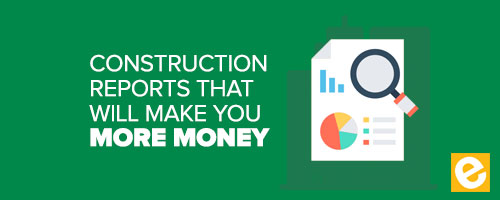
Construction Reporting that will Make You More Money
Table of Contents
Construction Reporting: Key Reports and Best Practices to Follow
Construction reporting refers to recording all activities, progress, and problems on a construction site. This documentation includes thorough records of the work, materials used, workforce, safety compliance, expenses, and any schedule or budget updates. The reports are an official record to help all stakeholders review and understand the project’s progress, identify potential issues, and ensure activities align with initial specifications and objectives.
Construction reporting is vital for construction projects because it provides a transparent and accountable way for project management. It facilitates stakeholder communication, including contractors, clients, and project managers. It also plays an important role in risk management by signaling issues early and allowing teams to act to mitigate delays or further costs. These reports are also crucial for legal and regulatory compliance, ensuring the project meets the required standards and regulations on a legal basis.
Types of Construction Reports
Construction projects involve many elements, each requiring a particular report or set of reports. While there are specific reports in multiple project areas, financial reports are the ones that usually track budgets and spending; progress reports log milestones; safety reports record regulatory compliance; and quality reports are the ones used to ensure high standards for the project. This approach helps multiple stakeholders oversee progress and improve decision-making processes, addressing unique challenges and needs in each area.
Daily Reports
Daily construction reports update on-site activities and status, often providing a thorough look exceeding contract guidelines. While contracts are the documents that initiate projects and set the ground, daily reports are vital because they capture nuances and help subcontractors and stakeholders effectively document, assess, and manage the project.
Materials Reports
Material reports track the use of materials, availability, and cost. They are important because they record efficient resource use, help teams identify shortages before they happen, and support the overall budgeting process. By having a clear outlook of the materials used, the project succeeds.
Cost Reports
Construction cost control is essential to prevent going over budget. It involves accounting for labor, materials, and potential additional costs to ensure timely project completion within scope and financial estimates. Cost reporting is a process that allows businesses to predict future cash flows and estimate final costs by tracking current project expenses.
Inspection Reports
Inspection reports evaluate work progress to ensure everything complies with initial plans, building codes, and safety standards. By anticipating any issues early on, these reports help businesses prevent problems and delays, keeping the project’s quality and safety on track. On top of that, these reports also have a purpose as a reference point, helping businesses become more transparent and improve accountability.
Trend Reports
These reports help businesses access valuable insights into market shifts, technological innovations, and material and labor cost fluctuations. They also help stakeholders develop strategies to face these changes while remaining competitive and profitable.
Safety Reports
Given its staffing nature, physical injuries or fatalities are an issue in the construction sector. Although multiple technologies and standards have been created to reduce safety risks, safety reports and procedures are essential to document incidents, evaluate safety protocols, and highlight improvement areas. Construction businesses should use safety reports and checklists to improve safety procedures, provide training, and ensure the usage of proper protective gear to prevent any incidents.
Punch Lists
A construction punch list is a detailed list of activities that must be done before a construction project is finished. Creating an accurate punch list ensures successful project delivery and avoids overwork and delays. Stakeholders should walk through the project together to make sure the punch list is successfully completed.
Work in Progress (WIP) Reports
WIP reports provide real-time insights into ongoing projects, including work completed, materials used, and costs. This report helps project managers stay on top of the project’s progress compared to the initial timelines and budgets, identifying discrepancies or delays and adjusting as needed. WIP reports also help businesses facilitate transparent communication, ensuring efficient execution and successful project delivery.
Best Practices Construction Reporting
Accurate, consistent, and transparent construction reports are vital in the construction industry. As we have already covered, these reports should cover work updates, financial updates, safety incidents, and materials used. Given the many details and complexity, standardized templates are excellent as they ensure consistency and help companies meet standards.
Technology has revolutionized reporting with real-time data collection and analysis. Digital tools automate data entry, reducing potential errors and facilitating open communication and information-sharing practices. Using them daily makes construction reports more accurate and accessible, ultimately helping you improve your business and meet best practices.
Use Construction Report Templates
Standard templates ensure consistency and accuracy in documentation among projects. They help companies streamline reporting, improve analysis, and facilitate stakeholder communication. Reports are your ally to improve efficiency and effectiveness in project management.
Construction Reporting Software Like eSUB can Help
Using construction reporting software like eSUB Cloud is essential to improve your reporting for your organization because it simplifies the entire process. Our solution was designed specifically for construction subcontractors, giving them a real-time view and account of their documents and processes and enabling them to manage them all within our easy-to-use platform.
Good Communication
Effective stakeholder communication is vital to improve efficiency and alignment. Regular exchanges and diligent reporting between project managers, contractors, clients, and other stakeholders are the foundations for comprehensive communication and collaboration. Aligning multiple parties is vital to enhancing management and improving the construction project’s efficiency and delivery.
Keep the Data Secure
Construction businesses must always secure financial details, contractual agreements, and personal worker’s data. While it may seem optional, security breaches can lead to monetary losses, legal issues, and reputational damage.
Top subcontractors care about handling and storing reports safely and encrypted for security purposes. These guardrails are necessary to comply with regulations, help you build trust and stand out among stakeholders, and ultimately are essential for business growth.